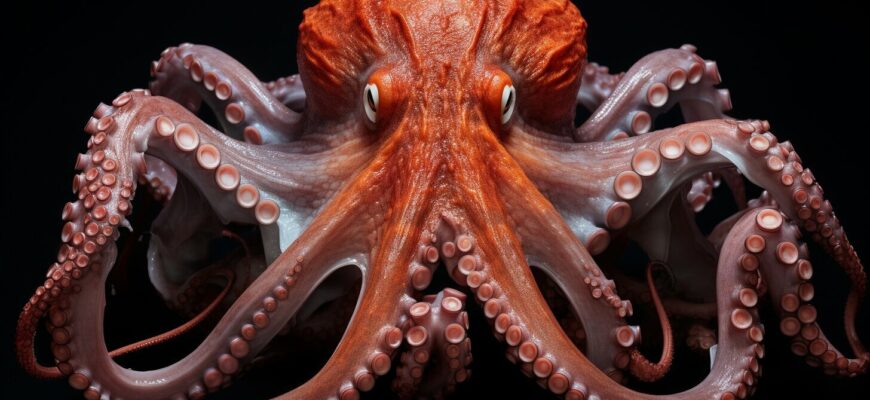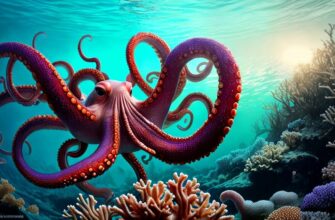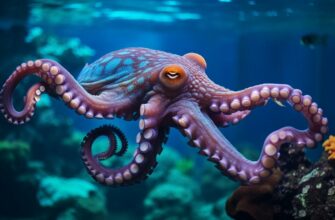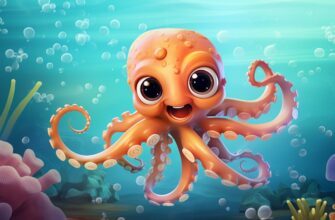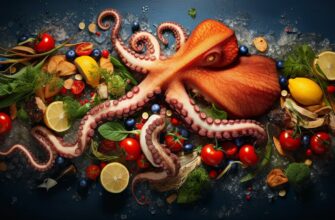Octopuses are some of the most mesmerizing creatures in the ocean. Their unique appearance and behavior have captivated researchers for decades. Have you ever wondered if octopuses have bones? In this article, we will explore the fascinating anatomy of these intriguing creatures and answer this question and more.
Octopuses are part of the cephalopod family and are known for their boneless bodies. Unlike most animals, they do not have a solid and rigid skeletal structure. Instead, they have a semi-solid structure made up of cartilage and connective tissue. This allows them to squeeze through tight spaces and move gracefully in the water.
- The Skeleton of an Octopus
- The Muscular Hydrostats
- Muscular System of an Octopus
- Using Tentacles for Hunting and Defense
- Octopus Strength and Flexibility
- Octopus Senses and Nervous System
- How do octopuses sense their surroundings?
- How does their nervous system work?
- What does their intelligence have to do with their senses?
- Internal Organs and Circulatory System of Octopuses
- Octopus Digestive System
- Octopus Reproductive System
- FAQ – Common Questions about Octopus Anatomy
- How many hearts do octopuses have?
- How do octopuses reproduce?
- Do octopuses have a brain?
- How do octopuses change color?
- Can octopuses regrow their limbs?
- What do octopuses eat?
- How do octopuses breathe?
- What is the lifespan of an octopus?
- Do octopuses have any natural predators?
The Skeleton of an Octopus
Octopuses are often referred to as “boneless” creatures, but that doesn’t mean they don’t have any structure at all. In fact, they have a complex and fascinating skeletal system that is quite different from that of other animals.
Unlike most animals, octopuses have no internal or external skeleton. Instead, their body is supported by a network of tough, fibrous tissues, including their muscles, skin, and connective tissues. These tissues work together to give the octopus its characteristic flexibility and range of motion.
The only hard parts of an octopus’s anatomy are its beak and a small, internal shell called the “stylet.” The beak is used to crush and tear apart prey, while the stylet acts as a support structure for the octopus’s digestive system.
The lack of a traditional bony skeleton also allows octopuses to squeeze through incredibly small openings and crevices, making them incredibly adaptable and versatile creatures.
The Muscular Hydrostats
One of the most interesting aspects of an octopus’s anatomy is its muscular hydrostats, which are found in each of the creature’s eight tentacles. These specialized structures allow the octopus to control the movements of each tentacle independently, making it easy for them to grasp and manipulate objects with remarkable accuracy and precision.
The muscular hydrostats work by using a system of muscles and fluids to move the tentacles in a variety of directions. When the muscles contract, they force fluid into small chambers called “muscle sacs,” which can then be moved and contorted, allowing the tentacle to bend and move in any direction.
This unique system of movement is not only incredibly precise, but also incredibly powerful. In fact, an adult octopus can easily lift objects that weigh many times their own body weight, thanks to the strength and flexibility of their muscular hydrostats.
Muscular System of an Octopus
The muscular system of an octopus is one of the most fascinating aspects of their anatomy. With their eight long, flexible tentacles, they are able to move with incredible agility and grace underwater. In fact, the way they use their tentacles for movement and manipulation is so unique that scientists have coined a term for it – “tentaculate locomotion.”
Octopuses have a muscular hydrostat system, which means that their muscles are not attached to bones like in other animals. Instead, they use the muscles in their tentacles to create movement and control their shape. By contracting and relaxing various muscle groups in their tentacles, octopuses are able to create a wide range of movements and perform complex tasks.
Their tentacles are also equipped with specialized suckers that help them grip and manipulate objects. These suckers are incredibly strong, and each one can support up to 35 pounds of weight. Octopuses can control each sucker independently, allowing them to handle objects with a high degree of precision.
Using Tentacles for Hunting and Defense
Octopuses use their tentacles for more than just movement and manipulation – they also use them for hunting and defense. When hunting, an octopus will use its tentacles to capture prey and bring it towards its sharp beak, which is located at the center of its arms. Once the prey is within reach of the beak, the octopus will use its radula – a tongue-like structure covered in small, sharp teeth – to tear it apart and consume it.
If an octopus feels threatened, it will use its tentacles to create a cloud of ink and then quickly swim away to safety. Additionally, some species of octopus are able to change the color and texture of their skin to blend in with their surroundings, which makes them harder to spot by predators.
Octopus Strength and Flexibility
Because they don’t have bones, octopuses are incredibly flexible and can squeeze into tight spaces with ease. They are also surprisingly strong – some species, like the North Pacific Giant Octopus, can exert up to 2,000 pounds of force with their tentacles.
Overall, the muscular system of an octopus is a marvel of nature. Their use of tentacles for movement, manipulation, hunting, and defense is truly unique and fascinating.
Octopus Senses and Nervous System
Octopuses are fascinating creatures with an impressive array of sensory abilities. Their nervous system is also highly developed, allowing them to process and react to information in their environment with lightning-fast speed.
How do octopuses sense their surroundings?
Octopuses have a variety of sensory organs that allow them to perceive their surroundings in a multitude of ways. One of the most important of these is their eyes. Octopuses have large, complex eyes that are similar to human eyes in many ways. They are capable of detecting color, shape, and light intensity, and can even perceive polarized light.
In addition to their eyes, octopuses also have a highly developed sense of touch. They have thousands of sensory receptors in their tentacles that allow them to detect even subtle changes in their environment. This sense of touch is so refined that octopuses are capable of distinguishing between objects with similar texture and shape.
Octopuses also have a keen sense of taste and smell. They have taste buds located on their arms and around their mouth, which allow them to detect chemicals in their environment. They also have a specialized structure called the olfactory organ, which is responsible for their sense of smell.
How does their nervous system work?
Octopuses have a centralized nervous system, which means that their brain is located in their head and sends out signals to the rest of their body. However, they also have a number of decentralized ganglia located throughout their body. This allows them to react quickly to stimuli and make complex, coordinated movements.
One of the most fascinating aspects of octopus nervous system is their ability to control their own coloration. They have specialized skin cells called chromatophores that allow them to change color and blend in with their surroundings. This color change is controlled by both the central nervous system and the decentralized ganglia located in their skin.
What does their intelligence have to do with their senses?
Octopuses have demonstrated a remarkable level of intelligence in a variety of tasks, which is believed to be connected to their highly developed sensory abilities. Their ability to process information from their environment quickly and accurately allows them to make complex decisions and adapt to changing circumstances. Studies have shown that octopuses are capable of problem-solving, using tools, and even learning from observation.
“Octopuses have a remarkable level of intelligence, which is believed to be connected to their highly developed sensory abilities.”
Overall, the sensory and nervous systems of octopuses are truly remarkable. Their ability to perceive and process information from their environment allows them to make complex decisions and adapt to changing circumstances. By studying these systems in greater detail, scientists hope to unlock the secrets of these fascinating creatures and gain a deeper understanding of how they interact with the world around them.
Internal Organs and Circulatory System of Octopuses
Octopuses have a complex internal anatomy that allows them to survive and thrive in their underwater habitats. Most of their organs are located in a muscular sac called the mantle, which also houses their gills and circulatory system. Unlike humans, who have a separate circulatory system for oxygen and nutrients, octopuses have a combined circulatory system, meaning that their blood carries both oxygen and nutrients.
One of the most fascinating features of the octopus circulatory system is their three hearts. Two of the hearts pump blood through the gills to oxygenate it, while the third heart pumps oxygen-rich blood throughout the rest of the body. This unique arrangement is essential for their survival in low-oxygen environments.
Octopuses also have a highly specialized respiratory system, which allows them to extract oxygen from water. Instead of using lungs like humans, octopuses have a series of gill-like structures that extract oxygen from water as it flows over them.
In addition to their circulatory and respiratory systems, octopuses have a range of internal organs that are crucial to their survival. These include their digestive system, reproductive system, and nervous system, which is especially sophisticated in these intelligent creatures.
Octopus Digestive System
The octopus digestive system is similar to that of other cephalopods, consisting of a long, winding gut that runs through the body. Food enters through the mouth and is broken down in the digestive tract before waste is expelled through the anus.
One unique feature of the octopus digestive system is their beak, a hard, sharp structure that allows them to break down tough prey like crabs and shellfish. Once the food is broken down, it is moved through the digestive tract and absorbed by the body.
Octopus Reproductive System
The octopus reproductive system is also unique, with males using a specialized arm called a hectocotylus to transfer a packet of sperm known as a spermatophore to the female. The female then lays her eggs in a protected area and cares for them until they hatch. Once the eggs hatch, the young octopuses are fully formed and can swim and hunt on their own.
Overall, the internal anatomy of octopuses is a fascinating example of the diversity of life on our planet. Their specialized circulatory, respiratory, digestive, and reproductive systems allow them to thrive in environments that would be hostile to most other creatures.
FAQ – Common Questions about Octopus Anatomy
As fascinating creatures, octopuses often spark curiosity and intrigue. Here are the answers to some of the most commonly asked questions about their unique anatomy.
How many hearts do octopuses have?
Octopuses have three hearts. Two of these hearts pump blood to their gills, while the third circulates blood to the rest of their body.
How do octopuses reproduce?
Octopuses reproduce sexually, with the male using one of his tentacles to transfer sperm to the female. The female lays her eggs in a den and guards them until they hatch.
Do octopuses have a brain?
Yes, octopuses have a complex nervous system with a highly developed brain. Their intelligence has been compared to that of a dog’s and they are capable of exhibiting problem-solving behavior.
How do octopuses change color?
Octopuses are masters of camouflage thanks to specialized skin cells called chromatophores. These cells contain pigments that can be expanded or contracted to alter the color and pattern of the octopus’ skin.
Can octopuses regrow their limbs?
Yes, octopuses have the ability to regrow lost limbs. This is due to their remarkable regenerative capabilities and is a unique trait among invertebrates.
What do octopuses eat?
Octopuses are predators and feed on a variety of prey, including crabs, shrimp, and fish. They are also known to use their tentacles to capture and eat small prey like snails and clams.
How do octopuses breathe?
Octopuses breathe through a set of gills, which are located inside their mantle. They pump water over their gills to absorb oxygen and expel carbon dioxide.
What is the lifespan of an octopus?
The lifespan of an octopus varies depending on the species. Some live only a few months, while others can live up to five years.
Do octopuses have any natural predators?
Octopuses have a few natural predators, including sharks, eels, and larger species of octopus. However, their impressive camouflage and ability to escape quickly make them difficult to catch.

